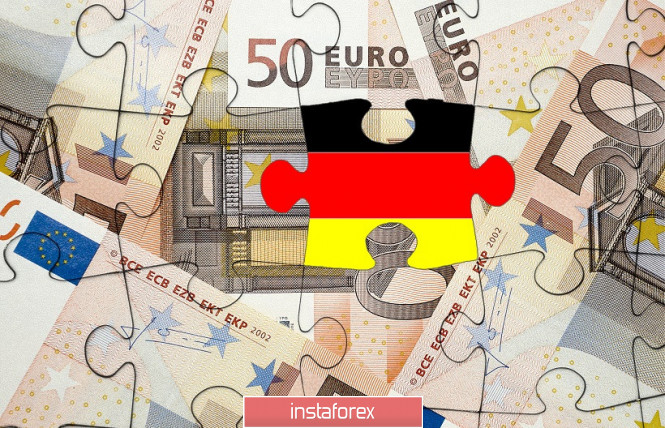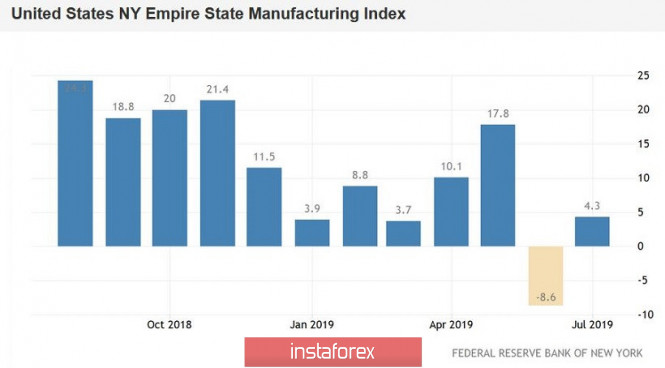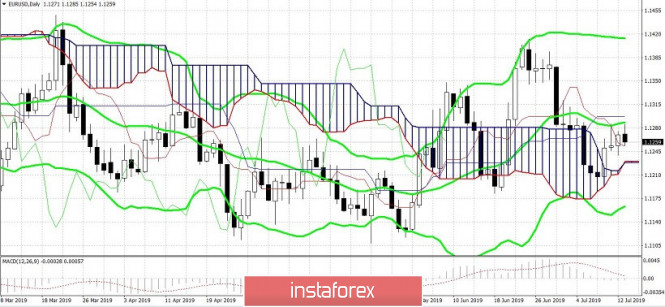At the beginning of the trading week, the euro-dollar pair continued a correctional growth after the release of fairly good data from China. However, during the day, EUR/USD bulls could not strengthen the upward impulse, as a result of which bears have then intercepted the initiative on the pair. This has contributed to the disappointing rhetoric of European officials against the background of strong data from the United States. Trump's threats to devalue the US currency have so far been sidelined, since all the information on this matter is in the nature of unverified rumors. In addition, according to some analysts, the US president will not be in a hurry with actions until the July Fed meeting, at which the regulator is likely to lower the interest rate.
Therefore, traders of the EUR/USD pair live today - and the overall results of Monday are clearly not in favor of the single currency. Thus, according to the German Minister of Economy Peter Altmeier, the key economic indicators suggest that in the second quarter of this year, the growth of the country's GDP will slow down significantly. This is indicated by the low growth of the service sector, as well as a slowdown in industrial activity. External demand is declining, and with a high degree of probability this trend will only gain momentum at the expense of a hard Brexit and the ongoing trade war between the US and China.

As is known, Germany is the "locomotive" of the European economy; therefore, such forecasts increase the likelihood of monetary policy easing by the European Central Bank. Here it is worth recalling that representatives of the ECB more and more often warn the market about such intentions. In particular, ECB member Benoit Coeure, who four years ago was one of the initiators of the launch of the stimulating program, said last week that the regulator could resume QE in the near future, if the situation in the eurozone economy demands it.
A similar position was voiced by ECB chief economist Philip Lane, whom the press already calls not only the central bank's chief economist but also the "chief adviser" to Mario Draghi's successor Christina Lagarde. According to many analysts, Lagarde will be guided precisely by his recommendations (at least for the first time), so the likelihood of mitigation of monetary policy conditions is growing due to this factor. Lane once again reiterated that the European regulator needs to pursue an accommodative policy in order to return inflation indicators to the targets, and the ECB "has enough tools" for this.
In the light of such rhetoric, currency strategists of the main European banks warn that the ECB can not only renew QE in the fall, but also lower the interest rate. In particular, according to analysts of the largest French bank Societe Generale, the regulator in September will cut the deposit rate by 10 basis points and announce the beginning of a stimulating program that will provide for a monthly purchase of assets in the amount of 40 billion euros. At the July meeting, according to analysts, the regulator widely announces easing of monetary policy. Therefore, the main reaction of the market regarding these steps will be in July, not in September.
However, the euro is already acting out such intentions of the ECB, being under background pressure. The only question is how aggressive the regulator's steps to mitigate monetary policy will be. Almost no one doubts that the ECB will follow this path.
That is why the potential for corrective growth of the EUR/USD pair was initially limited. Bulls could not take advantage of the temporary weakness of the dollar (which was due to rumors about Trump's intentions to devalue the currency through interventions) and go to the 13th figure. The pair touched the first resistance level of 1.1290 (the average line of the Bollinger Bands indicator on the daily chart) and headed towards the middle of the 12th figure. The formal reason for the downward pullback was published by the Federal Reserve Bank of New York's Empire State Manufacturing Index. In June, the indicator fell to a negative area (for the first time in 3.5 years), which alarmed dollar bulls. But today the index showed a positive trend, although it remained at relatively low values (4.3 points). The dollar reacted positively to this release, despite the fact that the employment component has remained at the lowest values since the fall of 2016.

Thus, the dovish intentions of the ECB exert background pressure on the euro, and this fact is a difficult "anchor" for the EUR/USD pair. The weight of this burden may intensify tomorrow, if the sentiment index in the business environment from the ZEW Institute (in Germany and in the whole of the eurozone) goes even deeper into the negative area. Given the high likelihood of a hard Brexit, the pessimism of the European business sphere will most likely grow and exponentially, will place additional pressure on the euro. In turn, the dollar will focus on retail sales tomorrow. This indicator may show negative dynamics, especially without car sales.

In other words, if political factors do not mix the cards of the fundamental picture, then weak US data will partially compensate for weak European indicators, especially in the light of the dovish intentions of both the ECB and the Fed. All this will lead to the fact that the pair will fluctuate in the price range with an upper ceiling of 1.1300 (Kijun-sen line on D1) and a lower limit of 1.1225 (the upper and lower boundaries of the Kumo cloud on the daily chart coincide at this price point). If the bears push the lower limit, the next support level will be the mark of 1.1160 - this is the bottom line of the Bollinger Bands indicator on the same timeframe.
The material has been provided by InstaForex Company - www.instaforex.com